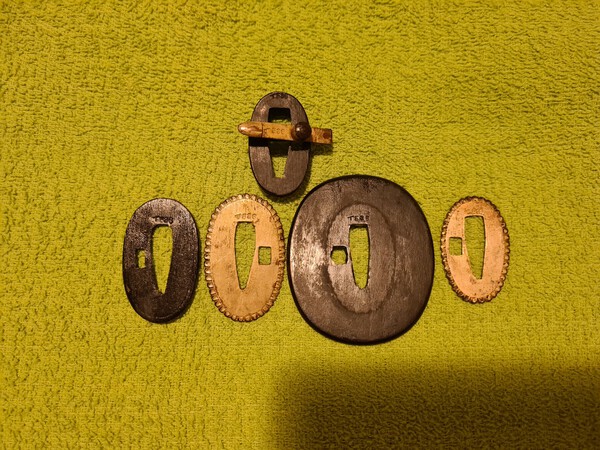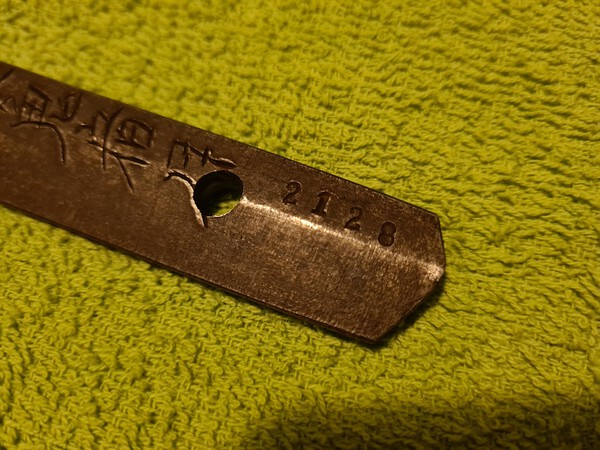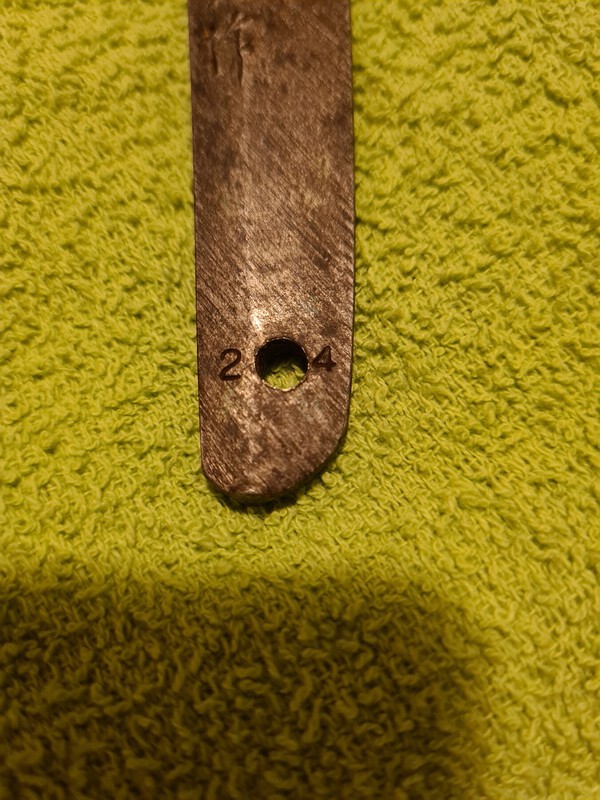-
Posts
13,432 -
Joined
-
Last visited
-
Days Won
159
Content Type
Profiles
Forums
Events
Store
Downloads
Gallery
Everything posted by Bruce Pennington
-

Arsenal Mark on RJT sword Fittings
Bruce Pennington replied to george trotter's topic in Military Swords of Japan
I've written to @Bruno to see if he has pics of the mei and date on that タ1399 blade. It should be an RJT smith. 1246 is Akimitsu and 2353 is Munitoshi. -
The really late-war saya were coarsely made wood with leather. But that doesn't account for all the years prior.
-
Hey guys! Looking for a translation of this unusual date inscription. The 1943 is obvious, but not getting anywhere with what follows it. (owned by an NMB member).
-
Another angle, that would matter to me if I were trudging about the hot sweltering jungles of SE Asia or Pacific islands - the wooden saya, leather covered, is WAY lighter than the metal. I have read somewhere that officers sometimes owned both, using the metal, fancy saya for office and the leather covered wooden for the field. Have no idea if that's true, though.
-
Andrew, There are a number of scattered pieces of this discussion all over NMB, but I don't think there is a dedicated thread to it (note: What a great topic for a thread!), so the abbreviated version is "all the above." Officers had to buy their own gunto, NCOs had them issued to them. Swords were sometimes brought from home. Some villages pooled together and commissioned a "sending off" sword. There were big sales events at Department stores, Sword clubs hosted sales, individual forges sold swords, and both the Army and Navy had Officers Clubs that sold swords. I cannot say whether the arsenals did any selling. In 1942, the Army Sword Office took control of all sword manufacturing for the war, so you see a concerted effort to funnel swords from all over the country into key arsenals. But how they got from there into the hands of officers, at that point, I cannot say. Good post about a 1942 sale in a department store, by Nick Komiya: https://www.warrelics.eu/forum/f216/1941-ija-weapons-prices-todays-values-786328-post2158440/#post2158440 and another: https://www.warrelics.eu/forum/f216/1941-ija-weapons-prices-todays-values-786328-post2154949/#post2154949
-
Admittedly I am a rookie at this, but I didn’t realize that pattern was so popular.
-
At first I thought I had posted that pattern, but after looking, post 20 and 53 are similar but this is still different. I bet the pattern has a name even!
-
Got more on my plate right now than I can handle too! I understand.Got more on my plate right now than I can handle too! I understand.
-

Arsenal Mark on RJT sword Fittings
Bruce Pennington replied to george trotter's topic in Military Swords of Japan
-
I can't find the thread that was started to discuss the dots, so posting this here. It's "Na" stamped on the mune. No star on the nakago On a Kanemitsu 1944 blade:
-
I have much to learn! Thanks Ed.
-

Arsenal Mark on RJT sword Fittings
Bruce Pennington replied to george trotter's topic in Military Swords of Japan
Ok, here's a couple to throw a monkey wrench in the issue: Both provided by Tim Blackburne 1. Akimitsu,1943, star-stamped, "Na" on mune, イ536 on all fittings ....... But 2128 on the blade and 2. Kanemitsu, 1944, no star, no stamps, "1" on fittings ..... But 24 on nakago -

Arsenal Mark on RJT sword Fittings
Bruce Pennington replied to george trotter's topic in Military Swords of Japan
Just got back from a long road-trip. I'll re-read all this tomorrow, a bit fog-headed now. George, I noticed the same thing happening with the Mantetsu numbers, beginning in 1942. We have 4-digit numbers, both in the 1000 and 2000 ranges in '42-'44. For a factory making 400 per month those serial numbers seem artificially high (even if they doubled their production numbers, it's still too high). Nick Komiya uncovered an Army document ordering serial numbers (I think it involved all weapons, not just swords) to randomize the numbers to hide production capabilities from the Allies. I suspect these large numbers might have been as a result of that order. It's significant, to me, that they start showing up after the Army took control of sword production. I am intrigued by your proposal that the list of forges are labeled with kana. It would be cool if a link could be found. To me, it would be impossible to prove with the limited amount of information we are working with, though. Your example with fittings marked with the same katakana & number sure seems to point to a shop putting it on the blade and fittings. I have seen shops match their fittings with the number on Mantetsu blades, but they didn't put the katakana on the fittings like this one. Yet, like Thomas pointed out, there must have been dozens of different ways shops worked their numbering systems. And this still doesn't eliminate the possibility that the blades were numbered by the forge, or Army inspector, and the shops simply mimicked the numbers. -
Back home and looked it over. The paint might be over an original brown. but it's very uniform like it was painted on before any dinks and dings could happen to the original paint. I've seen paint-jobs that were obviously done after multiple dings and chips. This wasn't like that. I also noticed that the wear patterns on this were almost identical to another 95 with original paint. So the gunto was worn/used during the war with this paint on it!
-
Ed, I wonder if the left and right facing swasticas were intentional or just part of the elaborate pattern. Anyone creative enough to make that pattern likely built it around the swastikas. I learned something tonight as I didn't know the "left" and "right" facing carried different meanings!
-
Wow, that's unusual! Almost looks like bamboo mats.
-
Stephen, Did the owner state whether the fittings were RS or Type 98? The nakago has 2 ana, like it was made for RS fittings, but I've got 2 others in this year-group made that way, but found in Type 98 fittings.
-
It is my understanding that each of the contractors indicated by their stamps made the whole sword, fittings and all. Someone may correct me if I am wrong about that.
-
Both great! keep them coming!
-
another
-
This is another example of what we have been struggling with, swords that are so poor we don’t think they’re original Japanese, but so good they don’t look like island swords. Like the one I just posted which had a clearly Japanese sword Smith signature, but a large number on the habaki. A theory is developing that these were made in China for the Japanese.
-
-
You’re right, thanks. And thanks for the extra photos! I was trying to use Thomas,’ fancy chart arranged in a different way, I didn’t read it right.
-
MOモ 104, so a 1943 blade with the Nan-ban Army Arsenal stamp. Thanks Stephen, a new one! Any chance of getting the full set of nakago shots?
-
It is a good book, but it was superseded by a newer version, same authors, in 1997. The newer version has more updated information and is more comprehensive. They learned a lot between the two books.
















